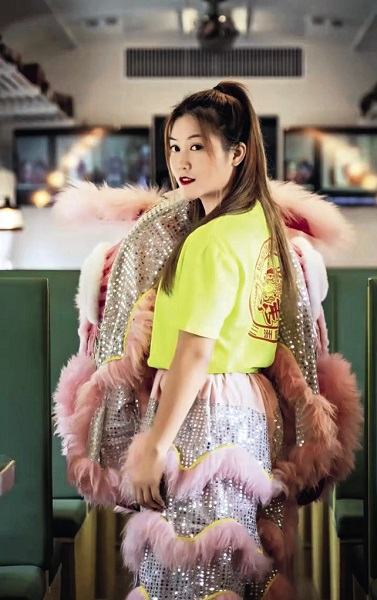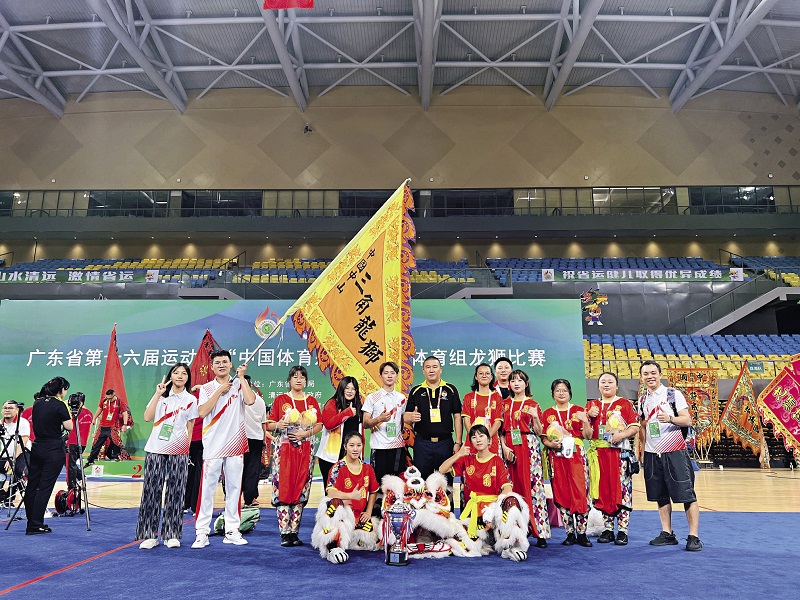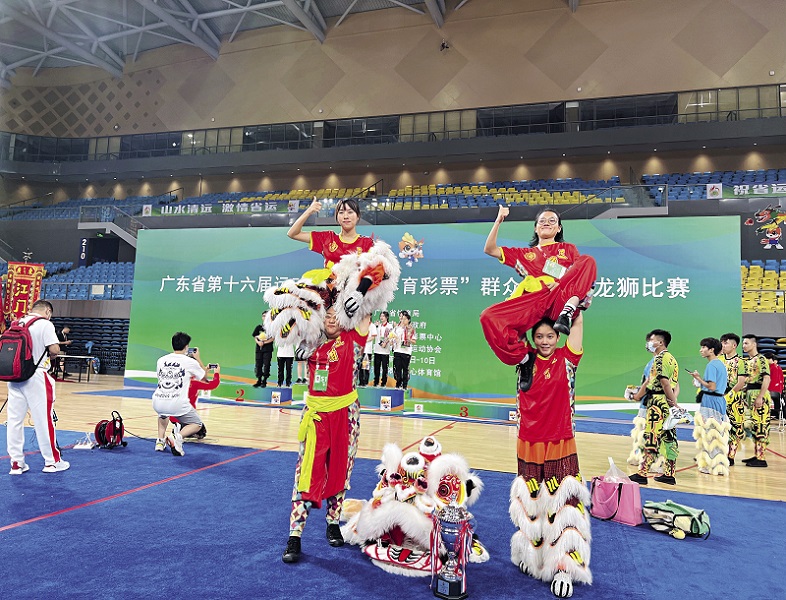
Liang Jiali practices beating a drum as part of her daily training routine.
Lion dance is very popular in China. As a well-known folk activity that is traditionally believed to bring prosperity and good luck, lion dance is often seen performed at festive occasions. Accompanied by the sound of beating drums, clashing cymbals, and resounding gongs, dancers dressed up in lion costumes jump back and forth, showing stunning Kung Fu and acrobatic skills. Crowds bursting into applause in response to the performance of this special kind of dancing always helps create a festive atmosphere that permeates the air.
Liang Jiali, a 28-year-old woman from Foshan City of Guangdong Province, is a high-pole lion dancer, who performs this art on poles arranged at different heights. At the age of seven, she was selected to join the Shunde Women’s Lion Dance Troupe, the only all-female high-pole team in China. Twenty-one years into her career, she has competed with countless men in the male-dominated lion dance industry.

Instead of the traditional red-yellow-black lion dance costume, Liang Jiali prefers wearing more fashionable colored costumes like this pink one.
A Career Interrupted and Resumed
In the 1990s, high-pole lion dancing was introduced and promoted in Nanhai of Foshan City. Different from traditional lion dancing, it has its own rules. Performers do not jump around on the ground but on poles ranging between one to three meters high. Besides, the space between poles also varies. The poles are often set up where dancers’ skills could be demonstrated while at the same time the audience can enjoy a safe and satisfying watching experience. It’s not easy to coordinate and balance well while performing the dance of a fierce lion so vividly on poles. That’s why compared with the traditional lion dance, the high-pole one is more challenging and dangerous.
Liang fell in love with high-pole lion dancing when she was in primary school. The sight of girls flying around on poles agilely and heroically fascinated her, but it wasn’t until she joined the training team that she came to realize how difficult and dangerous lion dancing can be. Liang still remembers how on the first day of training, the coach required her to stand on a high pole and jump from it to another pole 1.6 meters away.
It’s not uncommon to fall off poles during training. “When you hit the ground, you don’t know what’s going on. You just feel great pain.” In addition to the jumping, the daily training routines that include martial art squats, running, and weightlifting – much like scenes from Kung Fu movies – are also exhausting.
“The lowest pole was 1.4 meters high while the highest was three meters. I once suffered an injury to my left calf after falling off a two-meter-high pole, during which the bone in that leg was even exposed. I was in pain for one whole month.” Liang still vividly remembers the pain. After that incident, she seldom wore shorts or skirts as she does not want people to see the scars from that fall. Despite the pain and scars, in her heart the scars are a medal of honor. “Injuries are inevitable for an athlete, and every time I see those scars, I see my dreams,” she said.
When she was part of the Shunde Women’s Lion Dance Troupe, the only all-female lion dance team in China and the world, Liang and her teammates often went out to compete with male counterparts, and they won many competitions. In December 2010, their coach retired, and the troupe was disbanded.
With no other troupe to join, Liang had to choose another job to earn a living. During the period she could not do lion dancing from 2011 to 2017, she always felt a big hole in her heart. She eagerly wanted to continue pursuing her dream, but without a training venue and coach, she was totally at a loss as to how she could continue the sport.
Once Liang had a conversation with one of her old teammates who was very regretful that she had changed her career from lion dancing. Liang was deeply touched. Every time she saw lion dancers performing on the street, she would get excited. As a result, she was determined to pick up lion dancing again.
In 2017, Liang and one of her former teammates Huang Baoyi set out again. They started by doing small commercial shows and did some part-time jobs in male lion dance troupes. In 2019, a rare opportunity finally came. Li Peikun, head coach of the Lunjiao Sanzhou Dragon and Lion Troupe, offered them an olive branch after seeing their outstanding performance. Enrolled in a new troupe, they began to get more training and competition opportunities.

Liang Jiali (left, front) and her teammates participate in the dragon and lion dance competition of the 16th Sports Games of Guangdong, held from August 8 to 10.
Breathtaking Beauty
High-pole lion dancing has its unique charms. The poles are arranged in a style resembling mountains, streams, ropeways, and bridges. Dancers have to present the moods, such as happiness, anger, and drunkenness, of a lion. The dance combines martial arts, dance, acrobatics, gymnastics, and other difficult movements, showing a display of breathtaking beauty.
Looking back over her experience of the past years, Liang said that in Chinese society, lion dancing is still a male-dominated industry, and there are few full-time female dancers. In addition to overcoming physical challenge and the fear of jumping between poles at elevated locations, they also have to overcome many social prejudices compared with their male counterparts.
In the face of commercial opportunities, male lion dancers are normally preferred for the “masculinity” of their performance. When she competed with male counterparts in the past, some men would flaunt their superiority and even joke that their female counterparts had no chance at winning. Once, even a judge asked why she and her teammates did not choose simple actions.
More than this, not all her family members were supportive of her, especially her father. Whenever she came home with injuries incurred during lion dancing, some of her family would always try to persuade her to engage in something less dangerous and “more suitable for young women.”
But Liang said that to her, lion dancing was never gender specific, and she found her family’s reasoning unconvincing. “I wanted to break the prejudices against women in the workplace and show how excellent women could be,” Liang said. She recalled how Mo Guilan, wife of the renowned Chinese martial artist Huang Feihong (1847-1924), was part of the first generation of lion dancers, and now, men and women enjoy far more equality in carrying on cultural heritage. Determined to excel, she trained hard and spent lots of time studying the movements of lions, cats, and other feline animals to refine her dance moves.

Liang Jiali (right, bottom) is performing the role of a lion tail and holding her partner, the lion head, above her head at the dragon and lion dance competition of the 16th Sports Games of Guangdong.
Inheriting Culture
Liang Jiali has named her social media account “High-pole Lion Girls” on the Chinese short video platform Douyin, where she has around 150,000 followers. On this platform, she shares video clips of the daily training and competitions of her and her teammates. Many people in China and beyond have come to know more about high-pole lion dancing from her account.
Liang said that the “High-pole Lion Girls” represents a group of young women who love lion dancing, and she hopes to carry it forward and see more young women joining in.
In order to attract more young people, she has tried various strategies. For example, she made a blue and white lion head of her own, which was seen by many lion dancers of the older generation as a kind of the so-called “filial lion” that appears only during sacrificial occasions. But to Liang, compared with the traditional yellow-red-black lion heads, the blue-white one is more attractive to young people like her.
In addition, she has also tried to make lion dancing more visible. Apart from performing at the grand openings of shopping malls or celebrations, she and her teammates have performed at scenic spots to demonstrate classical lion dance movements to draw people’s attention. They have also made cultural products as a way of promoting public awareness of the art.
“Lion dancing is like a belief to me. I remember in 2010 when the dance troupe was disbanded, a close family member of mine passed away in the same year. I was very depressed at that time, at the age of 20. But when I was at my lowest point, I found great strength every time I watched lion dancing. I cherish the career I have now in lion dancing and I am trying to find more successors to pass it on.”